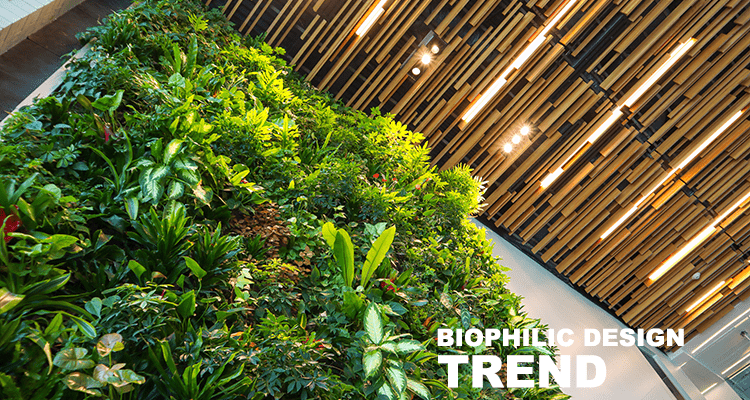Biophilic Design Trend at Homes are on the Rise Nowadays
Green consumerism is dramatically on the rise, reports market research company GWI, with half of all digital consumers stating that environmental concerns impact their purchasing decisions. This trend is specifically strong amongst millennials, around 61% of whom say they would pay for more environmentally friendly products and services. The penchant for sustainable, green living has taken on a whole new meaning in current times, when the global health crisis has forced many to find the human-nature connection at home. Biophilic design – which embraces energy efficiency, plants as a powerful design feature, and natural features as an inspiration for everything from furniture to décor items – fits right in with current thinking.
Why Turn To Nature?
The world is reeling under stress, with many developed nations reporting that up to 75% of people battle stress frequently. Job security, the evolution of current events, and global warming are just three sources of worry, and all, in some way or another, have to do with our relationship with nature. Studies have shown that living in green areas or inviting greenery into our homes can bring major benefits to our mental health. One study published in the journal Frontiers showed that taking just 20 minutes from one’s day to be outdoors significantly lowers stress hormone levels. Researchers concluded that a ‘nature pill’ a day could help reduce the negative health impacts which result from growing urbanization and ever-increasing screen time. Another study by University of East Anglia researchers showed that living close to nature has a wealth of health benefits – including a lower risk of heart disease, diabetes, high blood pressure, preterm death, and even premature death. Biophilic design can help bring these elements home at a time in which many may still be confined to their homes.
Natural Lighting
One of the pillars of biophilic design involves the use of natural light to lower energy consumption and fill the home with warmth and energy. Home renovation experts Mangum Home Builders report that one of the most popular means of bringing more light into a home is by knocking down concrete walls and embracing floor-to-ceiling glass walls and sliding doors. Just beyond these transparent frames, the beauty of nature can be appreciated via carefully manicured gardens, outdoor fireplaces, pergola-covered terraces, cobblestone pathways, low brick walls, and other nooks in which family members can bond in the midst of an oasis of greenery.
Greenery Everywhere
Indoor plants are one of the key components of biophilic design. If traditional home design sometimes includes one or two statement pots containing indoor plants, think of biophilic design as an explosion of green: one in which jungle vibes hold sway, and plants are present at a number of different levels. Think pot plants (vines and ferns) hanging from the ceiling in a thick, glorious fashion, as well as vines growing over dedicated wood structures, vertical gardens, and the like. The aim is to feel like you live inside an indoor garden in which the color green is present wherever you look. When hanging plants from above, ensure that a large space of your skylight or ceiling is covered, and opt for leaves bearing different lengths so the effect is lively and natural.
Complementing Green Life
Biophilic design also involves key choices of furniture that complement the magnificent greenery in common areas. Thus, in an open-plan type living room and kitchen, expect to find chairs upholstered in different leaf and flowery patterns, as well as rattan, wood, and other nature-inspired pieces. Tiles, particularly Mediterranean and Moroccan-style tiles, work particularly well in entrance halls, central patios, and outdoor terraces with room for fountains, benches, and other fixtures that can be covered in tiles hued in blue, green, and other colors taken from the outside world.
Indoor Oases
Even in indoor spaces that do not enjoy natural lighting – such as an indoor dining space – biophilic design can be embraced by the presence of wood – think wooden walls, ceiling beams and flooring, surrounded by vines, pots of all sizes and shapes, and living flowers. At night time, ensure this spot becomes magical through the use of solar fairy lights strewn along walls, beams, and any area containing height. Your table can also be given a cozy touch through candles, floral arrangements, vintage cutlery, and the use of a wooden table, graced with mismatched chairs in different hues and materials. Add to the rustic nature of it all by making your own hanging lanterns out of vintage glasses and jars, and use a blend of dried and natural flowers to fill the area with vibrancy.
Also Checkout:
- Pet Protection: 6 Smart Tricks for Dog-Friendly Home Parties
- Top 4 Outdoor Refrigerators for Your Home in Dubai
- Top 4 Outdoor Refrigerators for Your Home in Dubai
- 8 Best Home Workout Essentials You Should Get Right Now in UAE
The biophilic design trend is very much a product of decades of concern about the environment and more recent events. Suddenly, homes are more than a rest spot: they are a place to meet, connect, and potentially spend most of one’s day, both working and enjoying leisure activities with other home dwellers. Biophilic design can help reduce stress, add joy, and increase the warmth in your home design. Key pillars of this style include natural light, natural materials, and of course, as many plants as you can fit in your abode.




